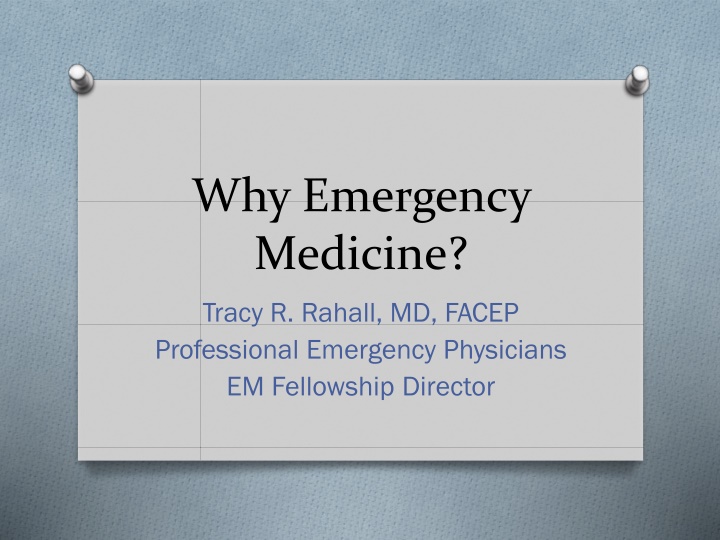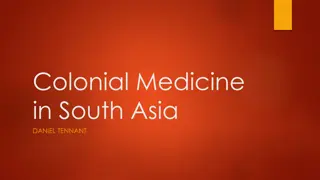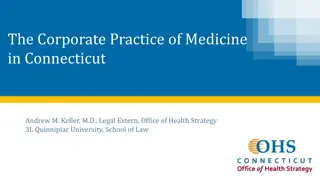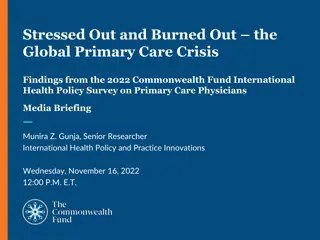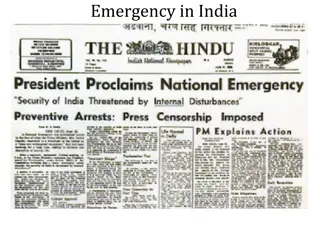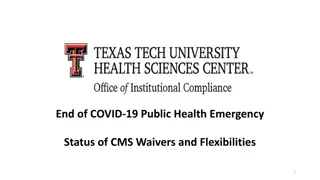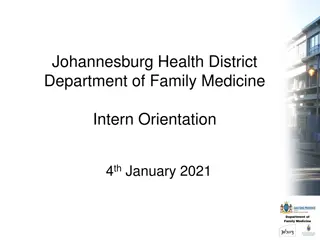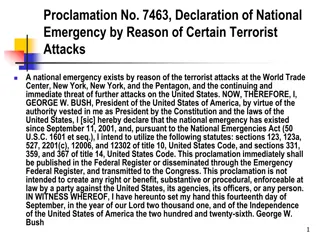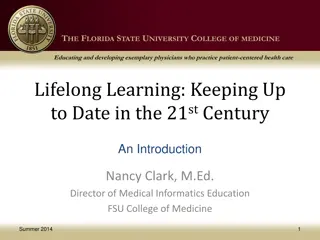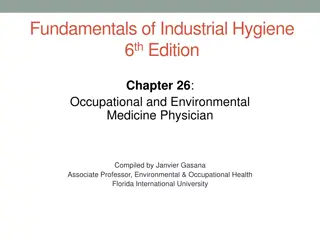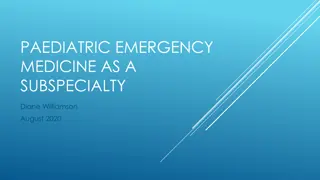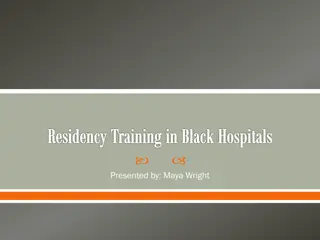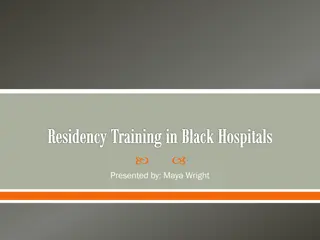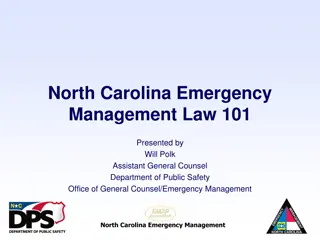The Role of Family Physicians in Emergency Medicine: A Historical Perspective
Family physicians have played a crucial role in the development of emergency medicine as a specialty, with many physicians transitioning and contributing to the field. Despite some controversy surrounding their role, organizations like AAFP have supported family physicians practicing emergency medicine, emphasizing their ability to deliver high-quality care. The collaboration between family medicine and emergency medicine has shaped the landscape of healthcare, ensuring essential services for patients in critical situations.
Download Presentation

Please find below an Image/Link to download the presentation.
The content on the website is provided AS IS for your information and personal use only. It may not be sold, licensed, or shared on other websites without obtaining consent from the author.If you encounter any issues during the download, it is possible that the publisher has removed the file from their server.
You are allowed to download the files provided on this website for personal or commercial use, subject to the condition that they are used lawfully. All files are the property of their respective owners.
The content on the website is provided AS IS for your information and personal use only. It may not be sold, licensed, or shared on other websites without obtaining consent from the author.
E N D
Presentation Transcript
Why Emergency Medicine? Tracy R. Rahall, MD, FACEP Professional Emergency Physicians EM Fellowship Director
AAFP Position O Family Physicians are an essential part of the emergency medicine safety net and without them large areas of the country would be without adequate emergency medical care O The Future of Family Medicine Project O This project is looking at a transformation of the U.S. health care system, in partnership with other organizations, including emergency medicine
AAFP O Family physicians can provide high quality and cost effective care. Look at history: O The birth of emergency medicine occurred because of the perceived need for physicians who were better trained in the care of critically ill or multiple trauma patients O 1979: Emergency medicine is sanctioned by the American Board of Medical Specialties as the 23rdmedical specialty O Family Medicine doctors championed the cause and many grandfathered into the practice of Emergency Medicine and sat for the Boards in the 1980s O Several charter members of ACEP (American College of Emergency Physicians) were family practitioners who fostered the development of the specialty O ABFP members were involved in the developmental phase of American Board of Emergency Medicine with their executive director serving on the ABEM board for several years
The Controversy O Although many family physicians currently provide emergency medicine care in a several different settings, their abilities to do so have been called into question within certain emergency medicine professional societies and organizations O ACEP even had a national media campaign promoting ABEM board certification as the only standard for emergency physician quality verification
The Controversy O In contrast, AAFP has supported its members who practice emergency medicine and have published a set of core curricular guidelines on acute and emergency care for residents in family medicine residency programs and developed a policy in 1995 which stated to the effect that family physicians are qualified to provide emergency care services
The Reality O 33% of family physicians provide emergency medical services with many making life-long careers in emergency medicine O There are not enough board-certified emergency medicine physicians to fill the emergency department staffing needs nationwide
Institute of Medicine Report O Conclusion: the Department of Health and Human Services partner with professional organizations (to) develop national standards for core competencies (in emergency and trauma care) using an evidence based, multi- disciplinary process O AAFP position paper
New Standards O The Future of Emergency Medicine Care in the United States Health System is a recent IOM report O Poor prognosis of emergency medicine in our nation unless significant changes occur O The system is fragmented with inconsistencies in the quality of care provided O It promotes the fundamental need for family physicians providing emergency care particularly in the rural setting
The Reality O AAFP position paper O Not withstanding the changes in family medicine residency requirements (more emphasis on emergency care) trainees in family medicine who plan to practice predominantly in an emergency care setting may need to further expand their clinical training. This would include additional skills in emergency procedures and trauma care, and more familiarity with the rapid, algorithmic approach that typifies advanced resuscitations
Critical Challenges for Family Medicine: Delivering Emergency Critical Challenges for Family Medicine: Delivering Emergency Medical Care Medical Care - - Equipping Family Physicians for the 21st Equipping Family Physicians for the 21st Century (Position Paper) Century (Position Paper) 2015 The most important objective of the physician must be the provision of the highest quality of care. Quality patient care requires that all providers should practice within their degree of ability as determined by training, experience and current competence. The AMA, AAFP and most medical specialties have adopted the policy that medical practice privileges be based on training, experience and demonstrated competence, not arbitrary specialty. The IOM report emphasizes that high quality, efficient, and reliable patient care can best be achieved through integrative approaches. Core competencies in emergency medicine should be evidenced based and multi-disciplinary. Family physicians are trained in the breadth of medical care, and as such are qualified to provide emergency care in a variety of settings. In rural and remote settings, family physicians are particularly qualified to provide emergency care. O O O O
Finances O EM O FP O $353K O $231K O Male vs Female O $368K vs $311K O Male vs Female O $258K vs $207K O 26% female O 42% female
Why a Fellowship? O The Goal: providing the highest quality of care O IOM report cites that high quality, efficient, and reliable care for the emergency patient is best achieved through integrative approaches such as the following: O 2006: joint training programs in FP and EM are approved by ABEM and ABFM O 1990s: Emergency Medicine fellowships O Do a second residency
Benefits of Emergency Medicine O Set hours O Set schedule O No call
Overhead O Typical Family Medicine practice overhead is 60% of revenues O Fam Pract. Manag. 2010 Mar-Apr.; 17 (2):38- 43. O Typical Emergency Medicine practice overhead is 46% of revenue O American College of Emergency Physicians. June 2009.
Family Practitioner Hours O The average family practice doctor will spend about 47 hours at work O This includes billing, reading mail, call, etc. O Most do 33 hours direct patient care with at least 1-1.5 additional hours after clinic each night completing charts/paperwork O Depending on whether they do evening clinic they may typically do at least 3-5 additional hours one night per week O Those that do deliveries may be on call one 24-7 shift every other week depending on the call schedule
Emergency Physician Hours O Department of Health and Human Services 2008 Report O Emergency medicine and critical-care doctors work fewer hours than any other specialty O The largest percentage (47%) of EM physicians work 30-40 hours per week O Medscape Emergency Medicine Compensation Report 2012
Pay O Medscape Physician Compensation Report 2017 O Family Medicine = $209K O Emergency Medicine = $339K
The Deceptive Income of Physicians O Ben Brown, MD O Physicians spend about 40,000 hours training and over $300,000 on their education, yet the amount of money they earn per hour is only a few dollars more than a high school teacher. Physicians spend over a decade of potential earning, saving, and investing time training and taking on more debt, debt that isn t tax deductible. When they finish training and finally have an income they are taxed heavily and must repay their debt with what remains. The cost of tuition, the length of training and the U.S. tax code places physicians into a deceptive financial situation. O benbrownmd.wordpress.com/
Is Emergency Medicine Right For Me? O Look at your objectives O Define your career goals O Appraise your unique personal characteristics O Examine whether these characteristics mesh with the unique aspects of practicing Emergency Medicine O Develop your plan to maximize long-term career satisfaction
What do you want? O Procedural expertise O Constant stimulation O Challenging clinical environment O Problem solving O Wide spectrum of illness and injury O Serve the public O Treat social ills O Schedule flexibility O Earning potential O Social prestige O Time with family O Scholarship O Independence O Organizational power O Academic vs community practice
Why PEP? O Democratic, well-managed group interested in and motivated to provide excellent patient care O Emphasis in ongoing education with free CME provided O Excellent facilities O Paid benefits O Competitive stipend O Equal pay for men and women Equal pay for men and women O Indiana in top 10 states for Indiana in top 10 states for physician salaries O Loan repayment opportunity O Post-fellowship employment opportunities physician salaries
PEP Contact Information O PEP = Professional Emergency Physicians, PC O https://www.professionalemergencyphysicia ns.com/ O 260-482-5091 O pepfellowship@pep-em.com
